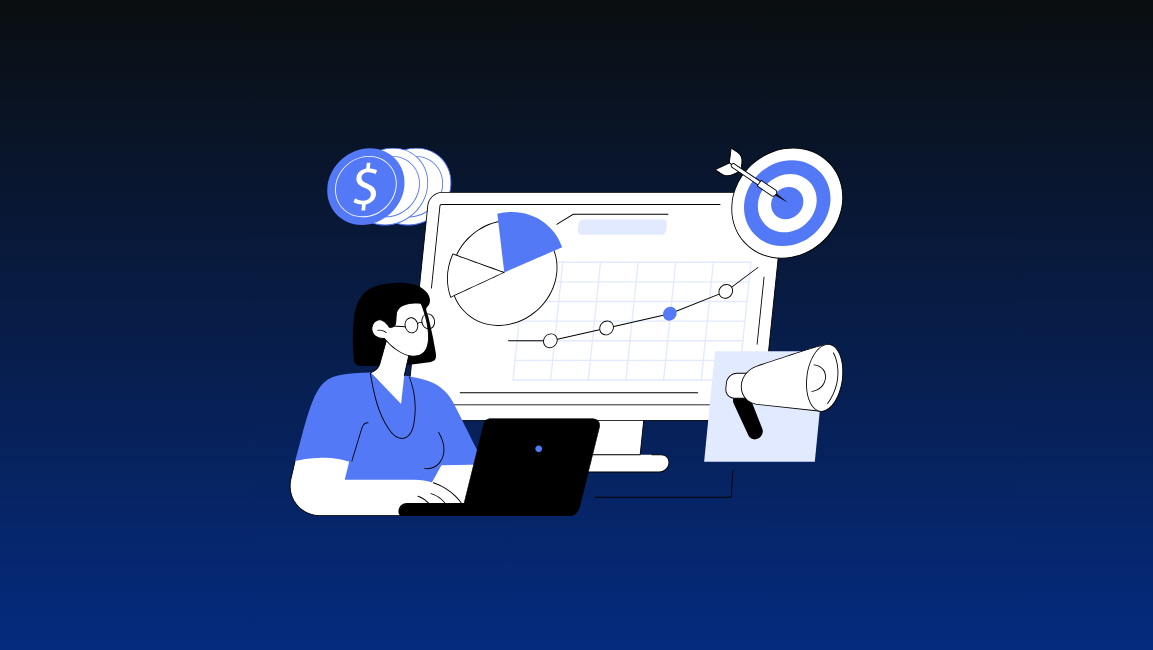6 Steps To Nailing Your Influencer Marketing Strategy
Getting noticed online is becoming increasingly challenging for brands. Why? Because there are so many businesses competing for attention. This overload of sponsored content makes people skeptical of brands that promote themselves too much, leading to a need for new, creative marketing methods.
Instead of blasting impersonal ads to the masses, an influencer marketing strategy lets you tap into the trust and credibility that influencers have built with their followers. Think about it: when someone you admire and trust recommends a product, aren’t you more likely to give it a try?
On top of that, with the rising costs of advertising, having a solid influencer marketing strategy helps you stabilize your costs (and make them more predictable).
In this blog post, we’ll walk you through the process of creating a successful influencer marketing strategy in 5 simple steps. Let’s get into it.
What is Influencer Marketing?
Influencer marketing allows businesses to team up with individuals who have a dedicated following and a strong influence over their audience. Brand-and-influencer partnerships range from micro-influencer endorsements to celebrity endorsements. The goal is to partner with the right influencers who will promote your products to their relevant (and targeted) audience.
So, if you run a skincare brand, you might partner with a beauty influencer whose followers are passionate about all things skincare. Their endorsement carries weight, and their followers are more inclined to check out your products. Pretty clever, right?
Daniel Wellington, the watches and accessories brand, sent social media influencers a unique, trackable promo code to share alongside their posts, offering exclusive discounts to their followers. This not only incentivized influencers’ audiences to engage with the brand but also provided Daniel Wellington with valuable data to measure the effectiveness of each influencer collaboration.
The results? Within just one year, Daniel Wellington amassed a new audience (1 million Instagram followers). In fact, it now boasts over 4.6 million followers on the platform.

Importance Of Influencer Marketing For Ecommerce Businesses
We all know the power of social media and content creators among today’s generations – 93% of people actively use it. This widespread presence has given rise to the concept of “social proof,” where people heavily rely on recommendations from those they follow and trust.
In fact, research shows that nearly 40% of Twitter users have made a purchase directly influenced by a tweet from an influencer.
This showcases the immense potential of influencer marketing as an effective strategy to build trust and brand recognition to drive sales for ecommerce businesses. Some other benefits of influencer marketing are:
Increased Brand Awareness and Visibility
Traditional advertising methods are becoming outdated. Whereas, influencer content creates a lasting impression, significantly increasing brand awareness – as reported by 78% of marketers. This is majorly because people trust influencers’ personal brands to share their opinions about the products they use, rather than just marketing it to increase sales.
Reaching the Right Audience at the Right Time
Approximately 44% of organizations find it difficult to reach the intended audience – those who are genuinely interested in online shopping. However, your influencer marketing strategy allows you to connect with your targeted audience at the right time, ensuring your message resonates with those most likely to convert.
Driving Traffic and Revenue Growth
Influencer marketing and the unique content created by influencers drive highly qualified traffic to your products and increase your revenue growth by using the power of community. They take advantage of the community built by the influencer and the trust to attract an audience who is already interested in similar things.
Tabs Chocolate, an edible dark chocolate brand faced advertising restrictions due to some reasons. Despite this, they were able to achieve remarkable success by focusing their efforts on influencers and organic reach. How?
They collaborated with an army of micro-influencers and leveraged platforms like TikTok, Instagram, and YouTube. Through this, they generated over 22 million views in just one month. This translated into a staggering 17% increase in gross merchandise value with an impressive 9.8x return on investment.
6 Steps To A Successful Ecommerce Influencer Marketing Strategy
Here is a step-by-step guide on how to build the perfect ecommerce influencer marketing strategy that targets the right audience and increases your brand awareness, ultimately leading to higher conversions.

Step 1: Settings SMART Goals & KPIs
Before diving into influencer marketing, your first step is to establish clear objectives and KPIs to measure success. Without defined objectives, your efforts will be aimless, difficult to evaluate, and prone to common mistakes. Start by setting SMART goals that ensure your influencer marketing strategy is on track. Wondering what SMART goals are? It’s an abbreviation of:
- Specific
- Measurable
- Achievable
- Relevant
- Time-sensitive
The ‘SMA’ part of this focuses on quantitative goals that allow you to objectively assess your campaign’s performance. These can include:
- Sales & revenue targets: Set financial goals to directly measure your influencer campaigns’ impact on sales.
- Social media traffic: Track visitors from creators to your social channels to gauge interest levels.
- Website traffic: Measure site visits driven by creators to see if campaigns successfully drive an audience.
- Engagement: Look at the number of likes, comments, shares, etc. to understand how well content resonates.
Now, the ‘RT’ part of this strategy includes subjective goals – ones that can’t be easily quantified. For this, you can measure:
- Brand awareness: Though hard to quantify, increased familiarity with your brand can significantly help boost conversions.
- Reach: Aim to get your brand in front of an expanded, relevant audience through influencers.
- Trust/Social proof: Leverage influencer endorsements to build credibility and trustworthiness.
However, don’t just pick these arbitrarily. Carefully consider what success looks like for your brand and create a content strategy that aligns with your goals.
For example, Topicals, a skincare company, was the first beauty brand to sponsor a trip exclusively for BIPOC individuals and feature smaller creators. They invited 18 influencers, including reality TV star Dami Hope, skincare expert Sean Garrette, and lifestyle creator Ishini Weerasinghe.
The result? Increased brand awareness because of the diversity in their choice of influencers. Plus, they gained 5,000 new followers on TikTok and Instagram.
Step 2: Setting Budgets (Gifting & Commission)
The next step is to establish timelines and budgets for your influencer marketing campaign. When planning an influencer campaign, it’s crucial to establish a realistic timeline that aligns with your objectives. Are you launching a new product? Aiming to boost sales during a holiday period? Or simply looking to increase your customer base and brand awareness? Your timeline will vary accordingly.
For instance, a product launch campaign may be more intensive over 1-3 months, with influencers posting frequently to generate buzz. Whereas an ongoing brand awareness campaign could have creators posting periodically throughout the year. Clearly defining the start and end dates helps influencers plan their content calendars effectively.
Now, coming to budgets, influencer marketing allows you to set your own budgets and control your spending. Unlike traditional advertising (we’re looking at you, Facebook ads) it doesn’t depend on your competitors.
When allocating your influencer marketing budget, there are three main points to consider:
- Influencer compensation: Influencer fees can vary based on factors like their platform, reach, engagement rates, and the type of collaboration (sponsored posts, shoutouts, affiliate programs, or extended partnerships). Some influencers would want a per-post fee plus a commission for every sale generated. Other, smaller influencers, would be happy with just the commission.
For example, DadGangs gives a 10% commission from every purchase to their affiliates.

- Product seeding: When you’re working with influencers, you have to send your product out to them. This is called “Product seeding.” Keep the cost of the product and shipping as part of your budget as well.
- Customer reward costs: If you’re planning to give a discount, or maybe a free product for every new customer who buys using the influencer referral link, you need to set the cost for this as well.
Step 3: Identifying Your Ideal Influencers
Invest time in thorough market research to understand your target audience’s preferences, behavior, and the platforms they frequent most. This research will guide you in choosing relevant influencers and channels to engage your audience effectively.
When evaluating potential influencers, consider the following factors:
- Is the influencer a niche creator? For example – a fashion influencer, a beauty influencer, a food Influencer, etc.? Alignment in topics and interests is crucial for promoting to a targeted audience.
- What is their engagement rate? While follower count is important, an influencer’s engagement rate is a better indicator of their audience’s authenticity and receptiveness to their content and whether they are a good fit or not. It could signal fake followers or an inauthentic presence.
- Have they collaborated with similar brands before? Creators can provide a press kit showcasing their portfolio and past successful partnerships, the type of content they create, what are their audience interests, etc.
Here are the different types of influencers you’ll come across. Keep in mind the different costs associated with the creators, based on their size:
- Celebrities: With millions of followers, these high-profile personalities offer immense exposure but come with hefty price tags.
- Macro-Influencers: Follower counts in the hundreds of thousands or millions, they have broad appeal but more reasonable rates than celebrities.
- Micro-Influencers: With niche, highly engaged audiences under 100K, micro-creators often provide the best bang for your buck with quality content, high engagement, and authentic connections.
- Nano-Influencers: These are everyday consumers with small, tight-knit followings under 10K. Nano-creators are usually less expensive but still have high engagement rates among their audience.
⛄️: Micro and Nano creators usually have the highest conversion rates.

Managing Your Creator Program
As you continue to grow your list of creators, you can add them to a creator-specific program on Social Snowball, the influencer marketing platform, where you can manage everything from program settings to rewards and commissions, as well as payouts and product seeding.

Otherwise, you’d have to manually track your affiliates using Excel or Google Sheets.

Step 4: Influencer Outreach
Once you’ve identified and vetted the ideal creators for your brand, it’s time to initiate outreach and lay the groundwork for a successful partnership. For example, for celebrities and macro-influencers, you may need to connect with management agencies to discuss potential collaboration opportunities and terms.
For micro-influencers, you can reach out to them manually. They usually have their emails available online. Then, you can use a tool like Gmass or Instantly.ai to send mass emails to your list.
Here’s what an example email would look like:

When it comes to influencer outreach, here are some tips:
- Do not pitch your affiliate program right away. This can discourage them from working with you.
- Offer them a free gift. If they like it, ask them to share it with their audience.
⛄️: Here’s our step-by-step influencer outreach playbook, for a full breakdown.
Step 5: Gamifying Your Influencer Program (Engagement)
After you’ve reached out to your creators and created a program in your Social Snowball dashboard, you should then begin sending them emails to engage your creators and grow your influencer relationships.
Here are some emails to include:
- Their personal affiliate link or discount code
- Notification when they’ve made a sale
- Success stories and case studies from other influencers
- Your brand values
- Content creation tools
- Past influencer marketing examples
- Influencer post ideas
On top of that, to gamify your program and really drive engagement, you should create different reward tiers with performance milestones that your affiliate tiers that your influencers can move through. The more sales they generate for your brand, the higher the reward!
Some examples of rewards include:
- Free gifts: Send your affiliates free products when they hit certain milestones
- Higher commissions: Move your affiliates to a higher, more VIP program as they hit higher milestones
Some examples of milestones you could measure include:
- Referral count: How many customers they referred to your brand
- Referral revenue: How much revenue they generated for your brand
Here is an example email from Divi, highlighting their reward tiers.

Step 6: Tracking Sales
The last (but the most important) step in creating a successful influencer marketing strategy is accurately tracking sales that have been generated by your affiliates.
This can be tracked with:
- Affiliate links
- Discount code usage
- Safelinks
What are Safelinks?
Safelinks are coupon code replacements that allow affiliates to share a discount to their audience without the risk of a code leaking to a coupon site. They look like normal affiliate links and can be shared wherever your affiliates are sharing codes.
Every shopper that clicks on a Safelink will have a single-use coupon code generated for them in real time when they land on your storefront.
Every customer who clicks on the link will have a different code, and since they’re all single-use, it doesn’t matter if they leak to a coupon site.

Conclusion
While influencer marketing requires some unique considerations to achieve campaign success, once you get a hang of it, creating different influencer marketing campaigns to meet your brand’s evolving needs will become second nature. And you’ll be able to hit your marketing goals at a much more predictable (and even affordable) cost.
Social Snowball allows you to manage your entire influencer strategy in one place, customize attribution settings, send bulk payments with just two clicks, and prevent coupon abuse with secure Safelinks. Request a demo today!




